Audit, Assurance, and Compliance - Individual Assignment 1 Report
VerifiedAdded on 2020/03/07
|10
|2852
|153
Report
AI Summary
This report analyzes audit, assurance, and compliance practices, focusing on a case study involving a printing organization, DIPL. The report delves into analytical procedures, highlighting how auditors assess financial statement accuracy through statistical and physical verification of transactions, with specific attention to cash, stock, and online orders. It explores inherent risks, such as those related to acquisitions and inventory valuation, and discusses fraud detection methods, emphasizing the importance of strong internal controls. The report provides insights into potential fraud areas, particularly in cash receipts and order processing, and suggests measures to mitigate these risks. The analysis underscores the significance of audit procedures in forming an opinion on the financial statements and ensuring the integrity of financial reporting.
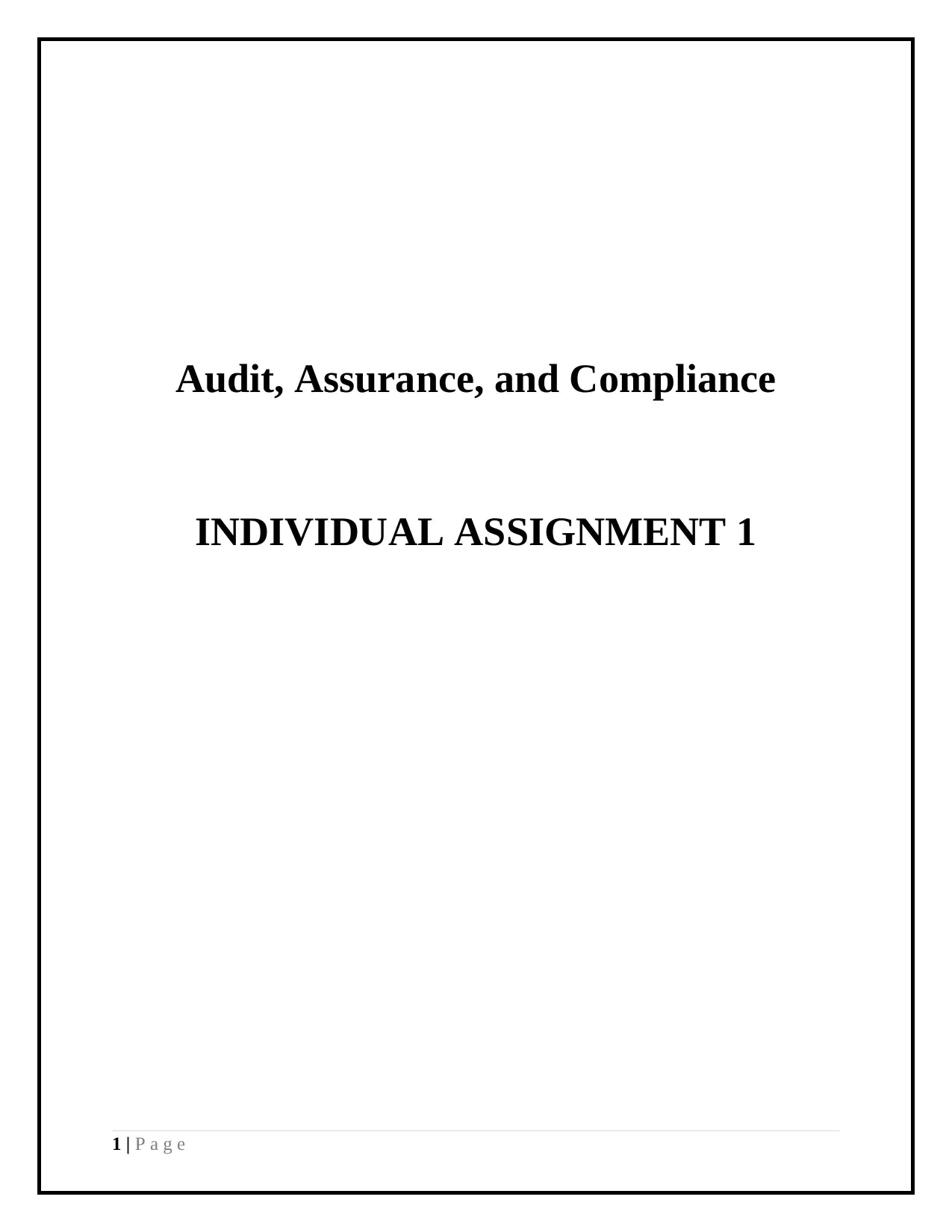
Audit, Assurance, and Compliance
INDIVIDUAL ASSIGNMENT 1
1 | P a g e
INDIVIDUAL ASSIGNMENT 1
1 | P a g e
Paraphrase This Document
Need a fresh take? Get an instant paraphrase of this document with our AI Paraphraser
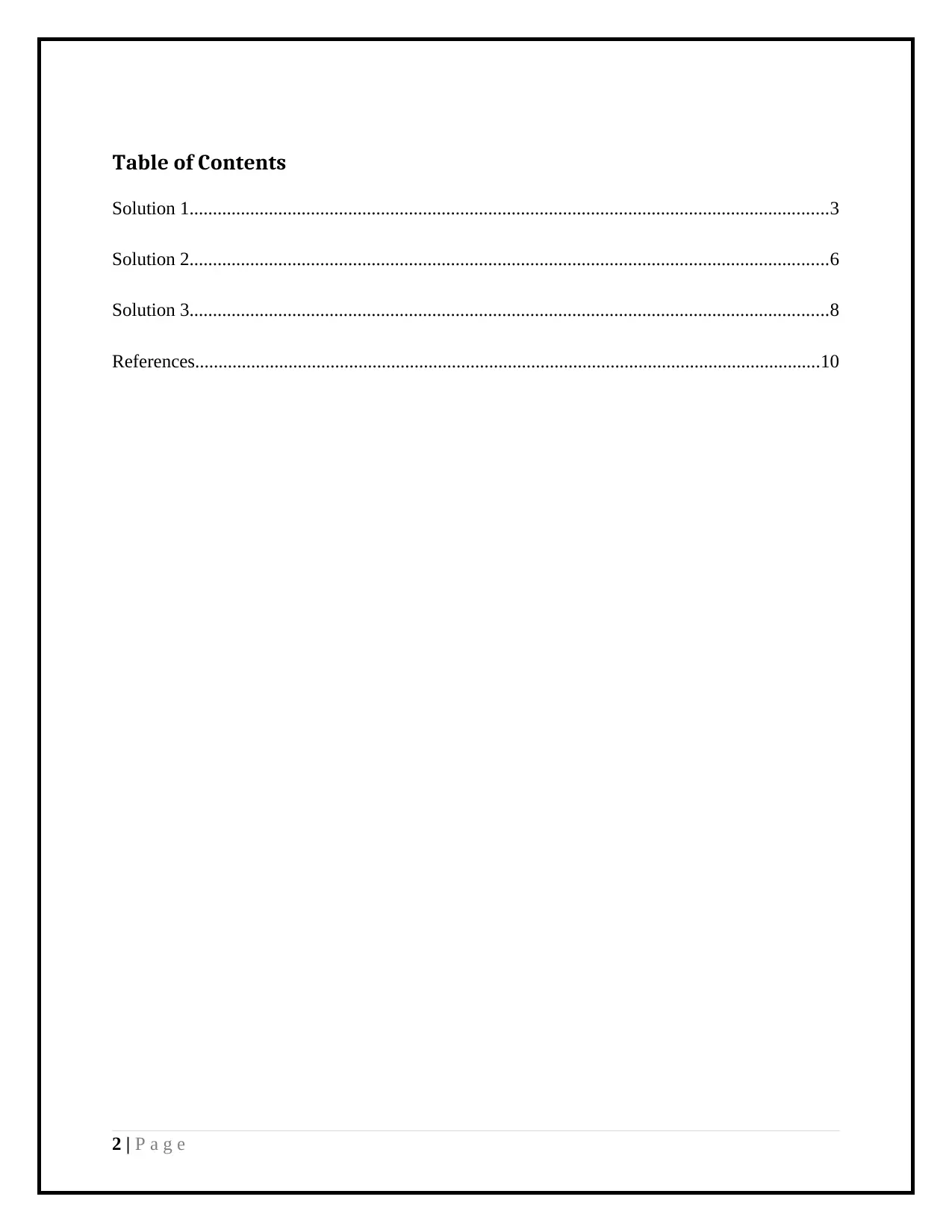
Table of Contents
Solution 1.........................................................................................................................................3
Solution 2.........................................................................................................................................6
Solution 3.........................................................................................................................................8
References......................................................................................................................................10
2 | P a g e
Solution 1.........................................................................................................................................3
Solution 2.........................................................................................................................................6
Solution 3.........................................................................................................................................8
References......................................................................................................................................10
2 | P a g e
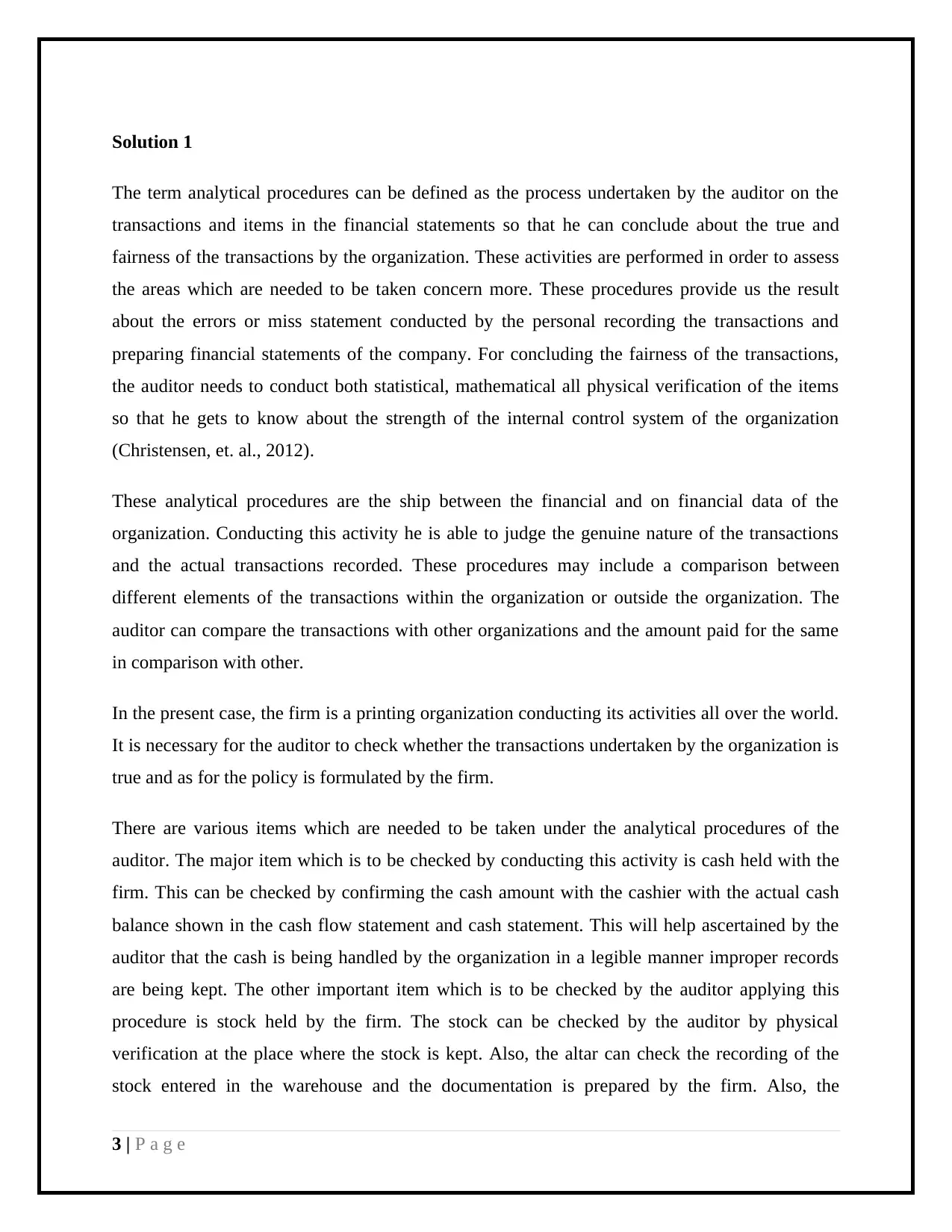
Solution 1
The term analytical procedures can be defined as the process undertaken by the auditor on the
transactions and items in the financial statements so that he can conclude about the true and
fairness of the transactions by the organization. These activities are performed in order to assess
the areas which are needed to be taken concern more. These procedures provide us the result
about the errors or miss statement conducted by the personal recording the transactions and
preparing financial statements of the company. For concluding the fairness of the transactions,
the auditor needs to conduct both statistical, mathematical all physical verification of the items
so that he gets to know about the strength of the internal control system of the organization
(Christensen, et. al., 2012).
These analytical procedures are the ship between the financial and on financial data of the
organization. Conducting this activity he is able to judge the genuine nature of the transactions
and the actual transactions recorded. These procedures may include a comparison between
different elements of the transactions within the organization or outside the organization. The
auditor can compare the transactions with other organizations and the amount paid for the same
in comparison with other.
In the present case, the firm is a printing organization conducting its activities all over the world.
It is necessary for the auditor to check whether the transactions undertaken by the organization is
true and as for the policy is formulated by the firm.
There are various items which are needed to be taken under the analytical procedures of the
auditor. The major item which is to be checked by conducting this activity is cash held with the
firm. This can be checked by confirming the cash amount with the cashier with the actual cash
balance shown in the cash flow statement and cash statement. This will help ascertained by the
auditor that the cash is being handled by the organization in a legible manner improper records
are being kept. The other important item which is to be checked by the auditor applying this
procedure is stock held by the firm. The stock can be checked by the auditor by physical
verification at the place where the stock is kept. Also, the altar can check the recording of the
stock entered in the warehouse and the documentation is prepared by the firm. Also, the
3 | P a g e
The term analytical procedures can be defined as the process undertaken by the auditor on the
transactions and items in the financial statements so that he can conclude about the true and
fairness of the transactions by the organization. These activities are performed in order to assess
the areas which are needed to be taken concern more. These procedures provide us the result
about the errors or miss statement conducted by the personal recording the transactions and
preparing financial statements of the company. For concluding the fairness of the transactions,
the auditor needs to conduct both statistical, mathematical all physical verification of the items
so that he gets to know about the strength of the internal control system of the organization
(Christensen, et. al., 2012).
These analytical procedures are the ship between the financial and on financial data of the
organization. Conducting this activity he is able to judge the genuine nature of the transactions
and the actual transactions recorded. These procedures may include a comparison between
different elements of the transactions within the organization or outside the organization. The
auditor can compare the transactions with other organizations and the amount paid for the same
in comparison with other.
In the present case, the firm is a printing organization conducting its activities all over the world.
It is necessary for the auditor to check whether the transactions undertaken by the organization is
true and as for the policy is formulated by the firm.
There are various items which are needed to be taken under the analytical procedures of the
auditor. The major item which is to be checked by conducting this activity is cash held with the
firm. This can be checked by confirming the cash amount with the cashier with the actual cash
balance shown in the cash flow statement and cash statement. This will help ascertained by the
auditor that the cash is being handled by the organization in a legible manner improper records
are being kept. The other important item which is to be checked by the auditor applying this
procedure is stock held by the firm. The stock can be checked by the auditor by physical
verification at the place where the stock is kept. Also, the altar can check the recording of the
stock entered in the warehouse and the documentation is prepared by the firm. Also, the
3 | P a g e
⊘ This is a preview!⊘
Do you want full access?
Subscribe today to unlock all pages.

Trusted by 1+ million students worldwide
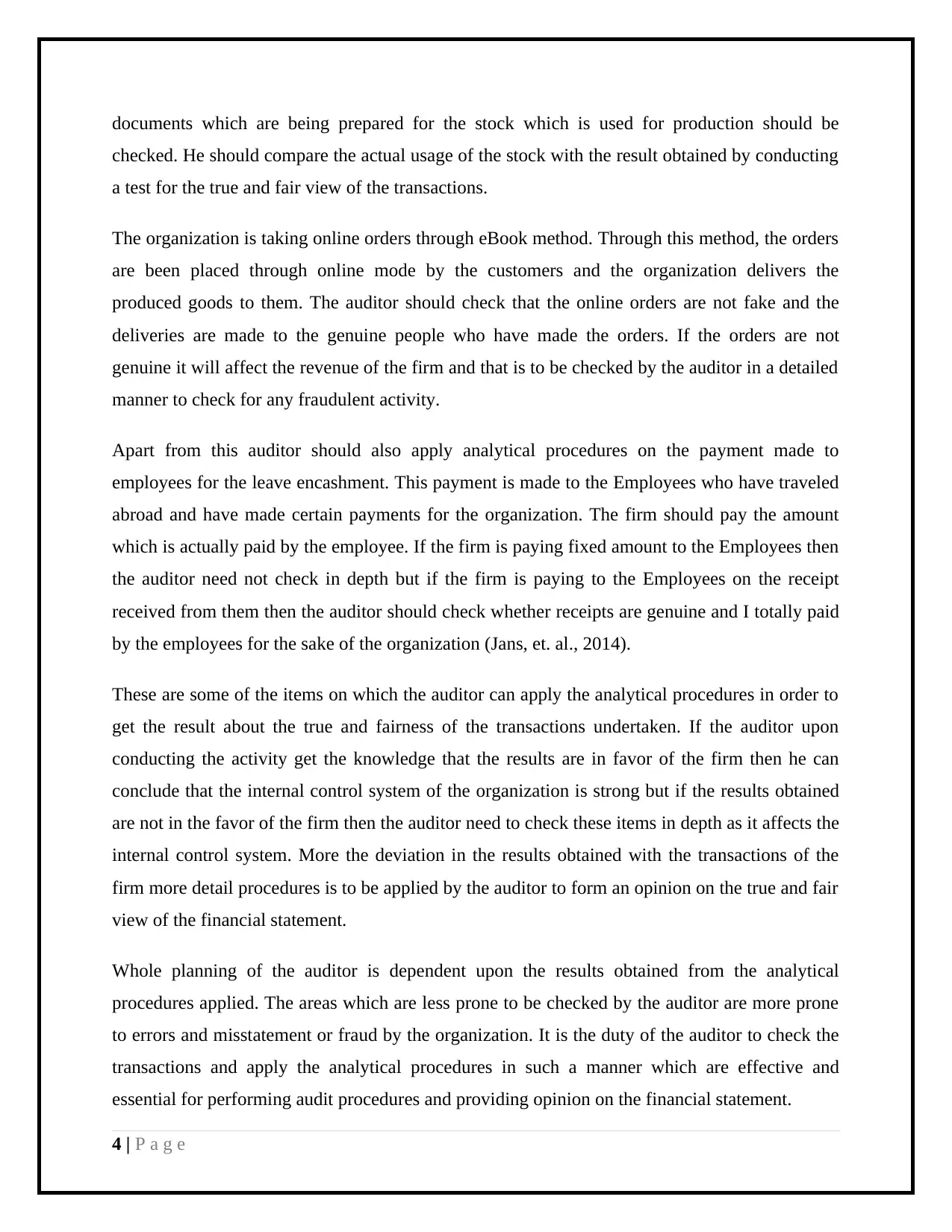
documents which are being prepared for the stock which is used for production should be
checked. He should compare the actual usage of the stock with the result obtained by conducting
a test for the true and fair view of the transactions.
The organization is taking online orders through eBook method. Through this method, the orders
are been placed through online mode by the customers and the organization delivers the
produced goods to them. The auditor should check that the online orders are not fake and the
deliveries are made to the genuine people who have made the orders. If the orders are not
genuine it will affect the revenue of the firm and that is to be checked by the auditor in a detailed
manner to check for any fraudulent activity.
Apart from this auditor should also apply analytical procedures on the payment made to
employees for the leave encashment. This payment is made to the Employees who have traveled
abroad and have made certain payments for the organization. The firm should pay the amount
which is actually paid by the employee. If the firm is paying fixed amount to the Employees then
the auditor need not check in depth but if the firm is paying to the Employees on the receipt
received from them then the auditor should check whether receipts are genuine and I totally paid
by the employees for the sake of the organization (Jans, et. al., 2014).
These are some of the items on which the auditor can apply the analytical procedures in order to
get the result about the true and fairness of the transactions undertaken. If the auditor upon
conducting the activity get the knowledge that the results are in favor of the firm then he can
conclude that the internal control system of the organization is strong but if the results obtained
are not in the favor of the firm then the auditor need to check these items in depth as it affects the
internal control system. More the deviation in the results obtained with the transactions of the
firm more detail procedures is to be applied by the auditor to form an opinion on the true and fair
view of the financial statement.
Whole planning of the auditor is dependent upon the results obtained from the analytical
procedures applied. The areas which are less prone to be checked by the auditor are more prone
to errors and misstatement or fraud by the organization. It is the duty of the auditor to check the
transactions and apply the analytical procedures in such a manner which are effective and
essential for performing audit procedures and providing opinion on the financial statement.
4 | P a g e
checked. He should compare the actual usage of the stock with the result obtained by conducting
a test for the true and fair view of the transactions.
The organization is taking online orders through eBook method. Through this method, the orders
are been placed through online mode by the customers and the organization delivers the
produced goods to them. The auditor should check that the online orders are not fake and the
deliveries are made to the genuine people who have made the orders. If the orders are not
genuine it will affect the revenue of the firm and that is to be checked by the auditor in a detailed
manner to check for any fraudulent activity.
Apart from this auditor should also apply analytical procedures on the payment made to
employees for the leave encashment. This payment is made to the Employees who have traveled
abroad and have made certain payments for the organization. The firm should pay the amount
which is actually paid by the employee. If the firm is paying fixed amount to the Employees then
the auditor need not check in depth but if the firm is paying to the Employees on the receipt
received from them then the auditor should check whether receipts are genuine and I totally paid
by the employees for the sake of the organization (Jans, et. al., 2014).
These are some of the items on which the auditor can apply the analytical procedures in order to
get the result about the true and fairness of the transactions undertaken. If the auditor upon
conducting the activity get the knowledge that the results are in favor of the firm then he can
conclude that the internal control system of the organization is strong but if the results obtained
are not in the favor of the firm then the auditor need to check these items in depth as it affects the
internal control system. More the deviation in the results obtained with the transactions of the
firm more detail procedures is to be applied by the auditor to form an opinion on the true and fair
view of the financial statement.
Whole planning of the auditor is dependent upon the results obtained from the analytical
procedures applied. The areas which are less prone to be checked by the auditor are more prone
to errors and misstatement or fraud by the organization. It is the duty of the auditor to check the
transactions and apply the analytical procedures in such a manner which are effective and
essential for performing audit procedures and providing opinion on the financial statement.
4 | P a g e
Paraphrase This Document
Need a fresh take? Get an instant paraphrase of this document with our AI Paraphraser
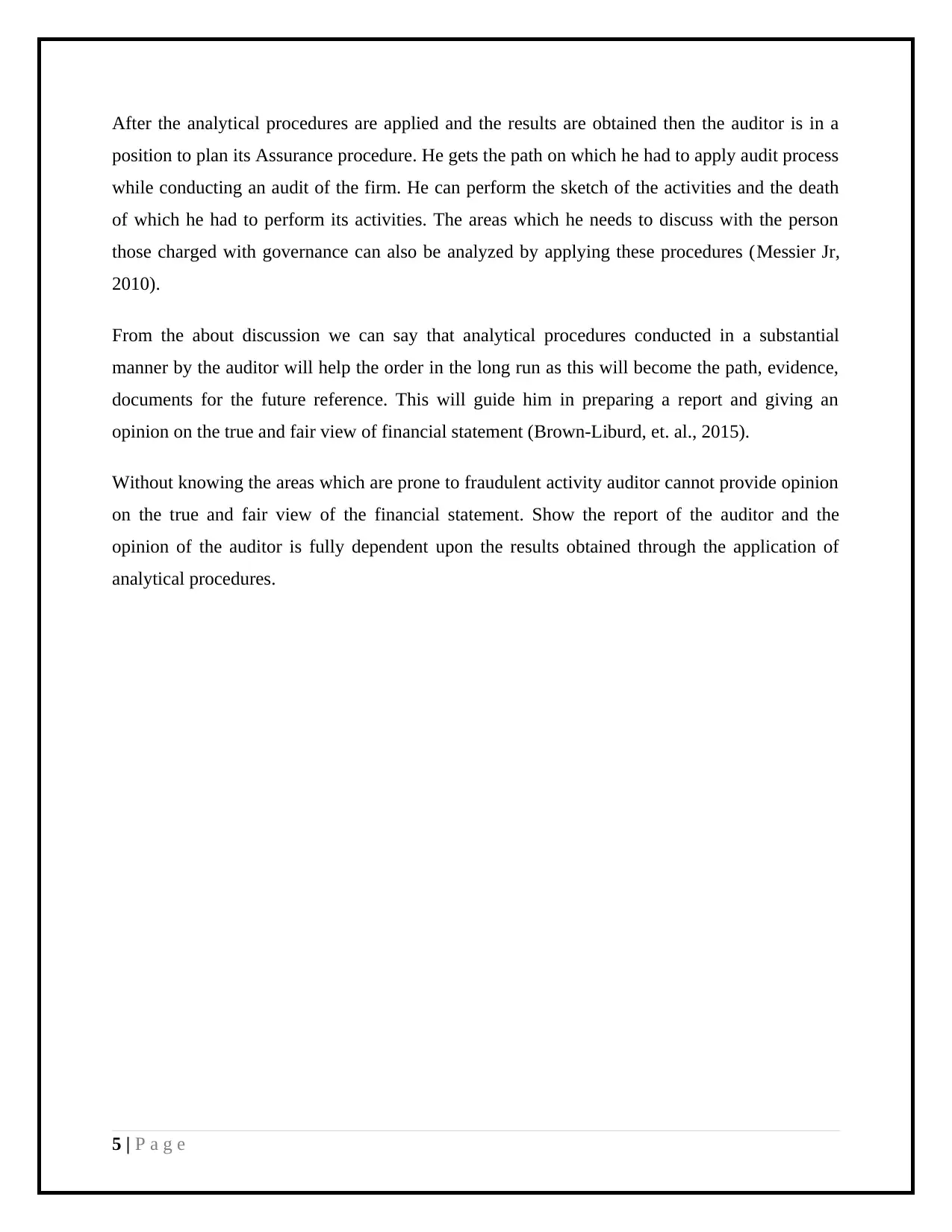
After the analytical procedures are applied and the results are obtained then the auditor is in a
position to plan its Assurance procedure. He gets the path on which he had to apply audit process
while conducting an audit of the firm. He can perform the sketch of the activities and the death
of which he had to perform its activities. The areas which he needs to discuss with the person
those charged with governance can also be analyzed by applying these procedures (Messier Jr,
2010).
From the about discussion we can say that analytical procedures conducted in a substantial
manner by the auditor will help the order in the long run as this will become the path, evidence,
documents for the future reference. This will guide him in preparing a report and giving an
opinion on the true and fair view of financial statement (Brown-Liburd, et. al., 2015).
Without knowing the areas which are prone to fraudulent activity auditor cannot provide opinion
on the true and fair view of the financial statement. Show the report of the auditor and the
opinion of the auditor is fully dependent upon the results obtained through the application of
analytical procedures.
5 | P a g e
position to plan its Assurance procedure. He gets the path on which he had to apply audit process
while conducting an audit of the firm. He can perform the sketch of the activities and the death
of which he had to perform its activities. The areas which he needs to discuss with the person
those charged with governance can also be analyzed by applying these procedures (Messier Jr,
2010).
From the about discussion we can say that analytical procedures conducted in a substantial
manner by the auditor will help the order in the long run as this will become the path, evidence,
documents for the future reference. This will guide him in preparing a report and giving an
opinion on the true and fair view of financial statement (Brown-Liburd, et. al., 2015).
Without knowing the areas which are prone to fraudulent activity auditor cannot provide opinion
on the true and fair view of the financial statement. Show the report of the auditor and the
opinion of the auditor is fully dependent upon the results obtained through the application of
analytical procedures.
5 | P a g e
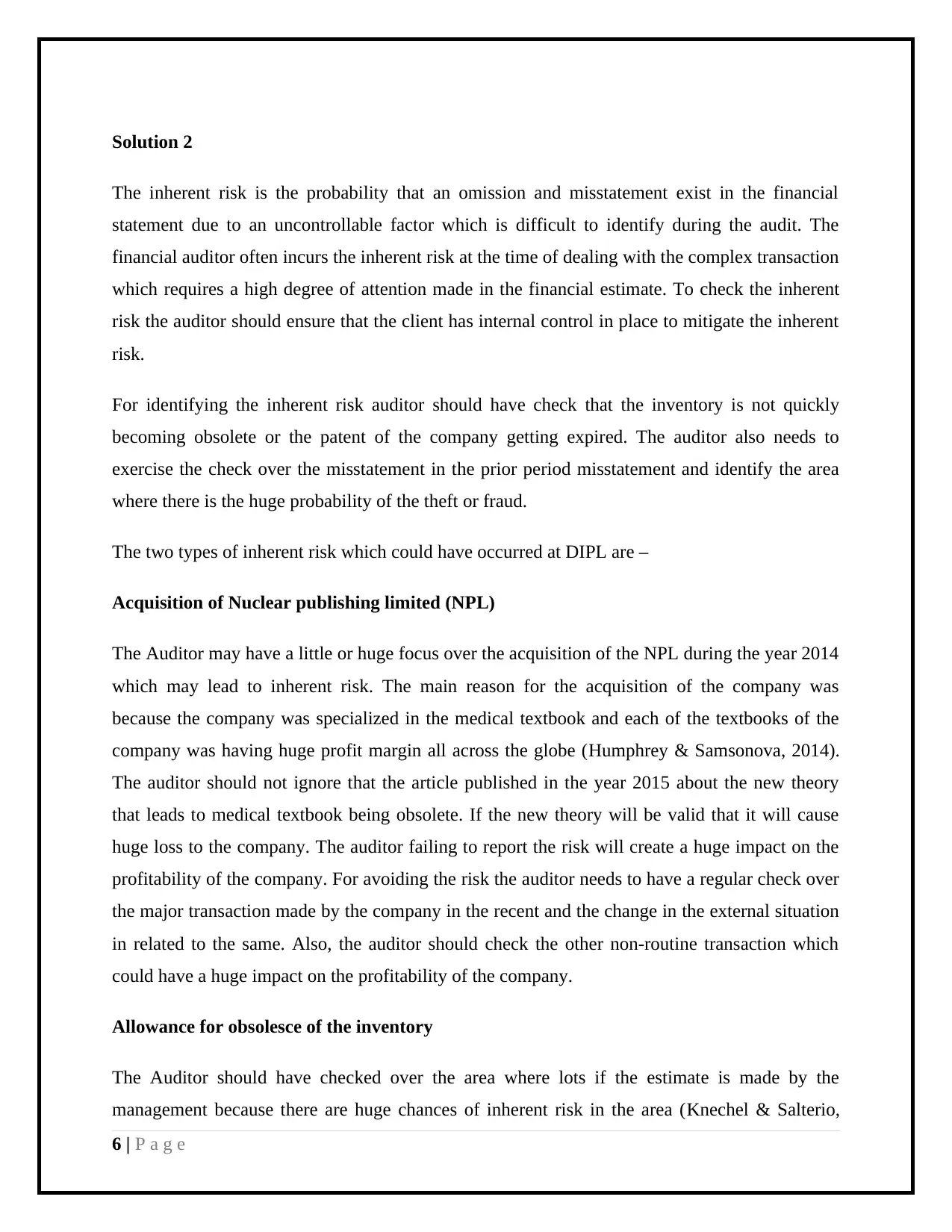
Solution 2
The inherent risk is the probability that an omission and misstatement exist in the financial
statement due to an uncontrollable factor which is difficult to identify during the audit. The
financial auditor often incurs the inherent risk at the time of dealing with the complex transaction
which requires a high degree of attention made in the financial estimate. To check the inherent
risk the auditor should ensure that the client has internal control in place to mitigate the inherent
risk.
For identifying the inherent risk auditor should have check that the inventory is not quickly
becoming obsolete or the patent of the company getting expired. The auditor also needs to
exercise the check over the misstatement in the prior period misstatement and identify the area
where there is the huge probability of the theft or fraud.
The two types of inherent risk which could have occurred at DIPL are –
Acquisition of Nuclear publishing limited (NPL)
The Auditor may have a little or huge focus over the acquisition of the NPL during the year 2014
which may lead to inherent risk. The main reason for the acquisition of the company was
because the company was specialized in the medical textbook and each of the textbooks of the
company was having huge profit margin all across the globe (Humphrey & Samsonova, 2014).
The auditor should not ignore that the article published in the year 2015 about the new theory
that leads to medical textbook being obsolete. If the new theory will be valid that it will cause
huge loss to the company. The auditor failing to report the risk will create a huge impact on the
profitability of the company. For avoiding the risk the auditor needs to have a regular check over
the major transaction made by the company in the recent and the change in the external situation
in related to the same. Also, the auditor should check the other non-routine transaction which
could have a huge impact on the profitability of the company.
Allowance for obsolesce of the inventory
The Auditor should have checked over the area where lots if the estimate is made by the
management because there are huge chances of inherent risk in the area (Knechel & Salterio,
6 | P a g e
The inherent risk is the probability that an omission and misstatement exist in the financial
statement due to an uncontrollable factor which is difficult to identify during the audit. The
financial auditor often incurs the inherent risk at the time of dealing with the complex transaction
which requires a high degree of attention made in the financial estimate. To check the inherent
risk the auditor should ensure that the client has internal control in place to mitigate the inherent
risk.
For identifying the inherent risk auditor should have check that the inventory is not quickly
becoming obsolete or the patent of the company getting expired. The auditor also needs to
exercise the check over the misstatement in the prior period misstatement and identify the area
where there is the huge probability of the theft or fraud.
The two types of inherent risk which could have occurred at DIPL are –
Acquisition of Nuclear publishing limited (NPL)
The Auditor may have a little or huge focus over the acquisition of the NPL during the year 2014
which may lead to inherent risk. The main reason for the acquisition of the company was
because the company was specialized in the medical textbook and each of the textbooks of the
company was having huge profit margin all across the globe (Humphrey & Samsonova, 2014).
The auditor should not ignore that the article published in the year 2015 about the new theory
that leads to medical textbook being obsolete. If the new theory will be valid that it will cause
huge loss to the company. The auditor failing to report the risk will create a huge impact on the
profitability of the company. For avoiding the risk the auditor needs to have a regular check over
the major transaction made by the company in the recent and the change in the external situation
in related to the same. Also, the auditor should check the other non-routine transaction which
could have a huge impact on the profitability of the company.
Allowance for obsolesce of the inventory
The Auditor should have checked over the area where lots if the estimate is made by the
management because there are huge chances of inherent risk in the area (Knechel & Salterio,
6 | P a g e
⊘ This is a preview!⊘
Do you want full access?
Subscribe today to unlock all pages.

Trusted by 1+ million students worldwide
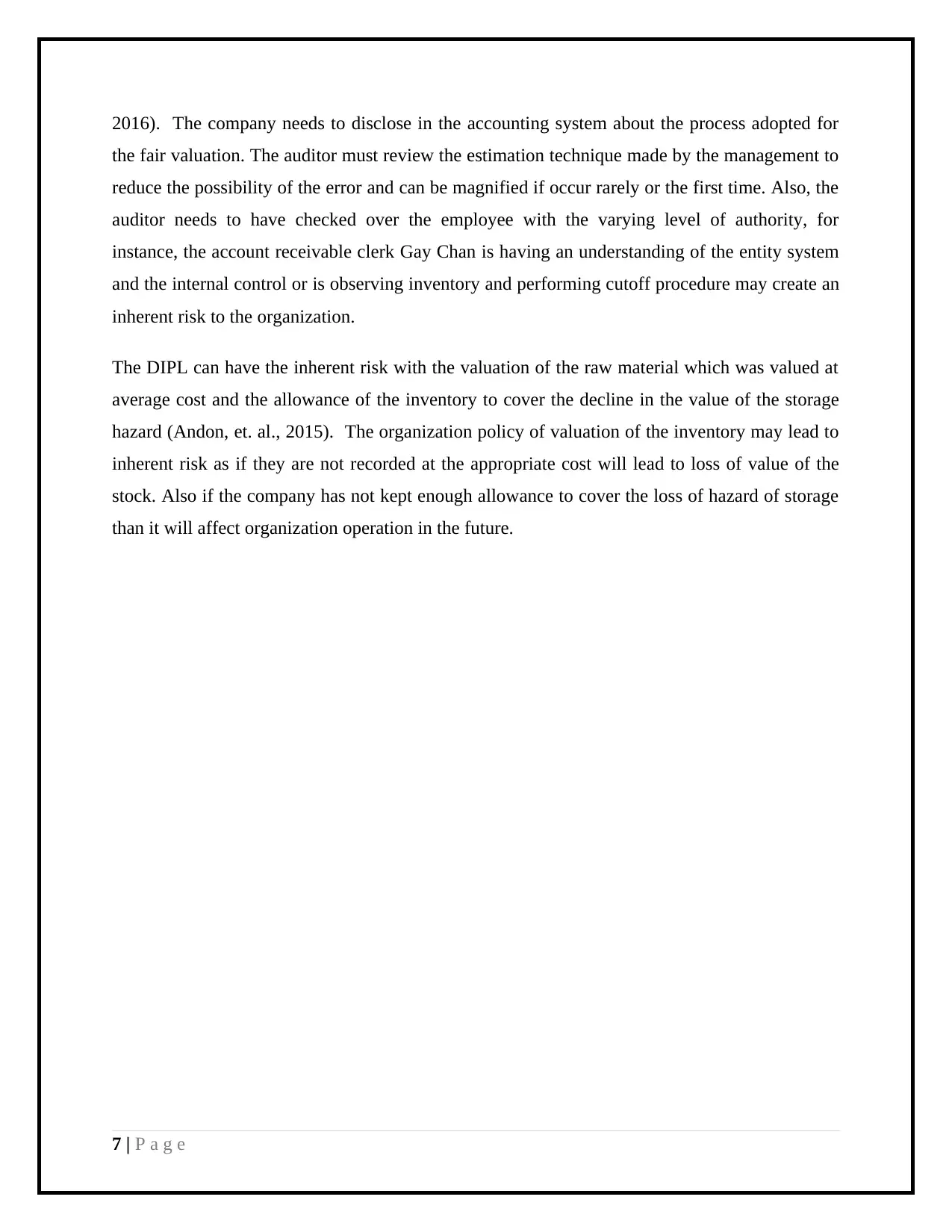
2016). The company needs to disclose in the accounting system about the process adopted for
the fair valuation. The auditor must review the estimation technique made by the management to
reduce the possibility of the error and can be magnified if occur rarely or the first time. Also, the
auditor needs to have checked over the employee with the varying level of authority, for
instance, the account receivable clerk Gay Chan is having an understanding of the entity system
and the internal control or is observing inventory and performing cutoff procedure may create an
inherent risk to the organization.
The DIPL can have the inherent risk with the valuation of the raw material which was valued at
average cost and the allowance of the inventory to cover the decline in the value of the storage
hazard (Andon, et. al., 2015). The organization policy of valuation of the inventory may lead to
inherent risk as if they are not recorded at the appropriate cost will lead to loss of value of the
stock. Also if the company has not kept enough allowance to cover the loss of hazard of storage
than it will affect organization operation in the future.
7 | P a g e
the fair valuation. The auditor must review the estimation technique made by the management to
reduce the possibility of the error and can be magnified if occur rarely or the first time. Also, the
auditor needs to have checked over the employee with the varying level of authority, for
instance, the account receivable clerk Gay Chan is having an understanding of the entity system
and the internal control or is observing inventory and performing cutoff procedure may create an
inherent risk to the organization.
The DIPL can have the inherent risk with the valuation of the raw material which was valued at
average cost and the allowance of the inventory to cover the decline in the value of the storage
hazard (Andon, et. al., 2015). The organization policy of valuation of the inventory may lead to
inherent risk as if they are not recorded at the appropriate cost will lead to loss of value of the
stock. Also if the company has not kept enough allowance to cover the loss of hazard of storage
than it will affect organization operation in the future.
7 | P a g e
Paraphrase This Document
Need a fresh take? Get an instant paraphrase of this document with our AI Paraphraser
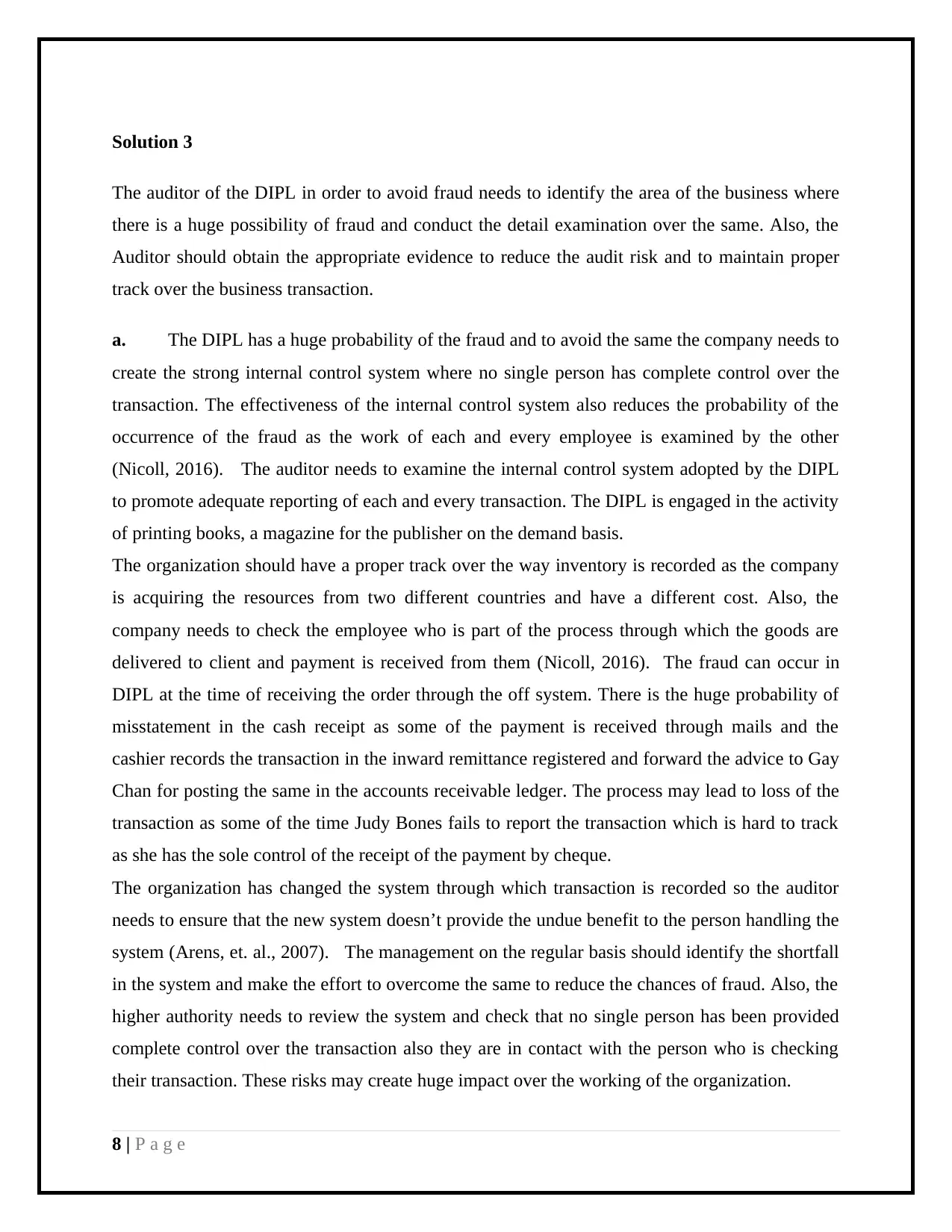
Solution 3
The auditor of the DIPL in order to avoid fraud needs to identify the area of the business where
there is a huge possibility of fraud and conduct the detail examination over the same. Also, the
Auditor should obtain the appropriate evidence to reduce the audit risk and to maintain proper
track over the business transaction.
a. The DIPL has a huge probability of the fraud and to avoid the same the company needs to
create the strong internal control system where no single person has complete control over the
transaction. The effectiveness of the internal control system also reduces the probability of the
occurrence of the fraud as the work of each and every employee is examined by the other
(Nicoll, 2016). The auditor needs to examine the internal control system adopted by the DIPL
to promote adequate reporting of each and every transaction. The DIPL is engaged in the activity
of printing books, a magazine for the publisher on the demand basis.
The organization should have a proper track over the way inventory is recorded as the company
is acquiring the resources from two different countries and have a different cost. Also, the
company needs to check the employee who is part of the process through which the goods are
delivered to client and payment is received from them (Nicoll, 2016). The fraud can occur in
DIPL at the time of receiving the order through the off system. There is the huge probability of
misstatement in the cash receipt as some of the payment is received through mails and the
cashier records the transaction in the inward remittance registered and forward the advice to Gay
Chan for posting the same in the accounts receivable ledger. The process may lead to loss of the
transaction as some of the time Judy Bones fails to report the transaction which is hard to track
as she has the sole control of the receipt of the payment by cheque.
The organization has changed the system through which transaction is recorded so the auditor
needs to ensure that the new system doesn’t provide the undue benefit to the person handling the
system (Arens, et. al., 2007). The management on the regular basis should identify the shortfall
in the system and make the effort to overcome the same to reduce the chances of fraud. Also, the
higher authority needs to review the system and check that no single person has been provided
complete control over the transaction also they are in contact with the person who is checking
their transaction. These risks may create huge impact over the working of the organization.
8 | P a g e
The auditor of the DIPL in order to avoid fraud needs to identify the area of the business where
there is a huge possibility of fraud and conduct the detail examination over the same. Also, the
Auditor should obtain the appropriate evidence to reduce the audit risk and to maintain proper
track over the business transaction.
a. The DIPL has a huge probability of the fraud and to avoid the same the company needs to
create the strong internal control system where no single person has complete control over the
transaction. The effectiveness of the internal control system also reduces the probability of the
occurrence of the fraud as the work of each and every employee is examined by the other
(Nicoll, 2016). The auditor needs to examine the internal control system adopted by the DIPL
to promote adequate reporting of each and every transaction. The DIPL is engaged in the activity
of printing books, a magazine for the publisher on the demand basis.
The organization should have a proper track over the way inventory is recorded as the company
is acquiring the resources from two different countries and have a different cost. Also, the
company needs to check the employee who is part of the process through which the goods are
delivered to client and payment is received from them (Nicoll, 2016). The fraud can occur in
DIPL at the time of receiving the order through the off system. There is the huge probability of
misstatement in the cash receipt as some of the payment is received through mails and the
cashier records the transaction in the inward remittance registered and forward the advice to Gay
Chan for posting the same in the accounts receivable ledger. The process may lead to loss of the
transaction as some of the time Judy Bones fails to report the transaction which is hard to track
as she has the sole control of the receipt of the payment by cheque.
The organization has changed the system through which transaction is recorded so the auditor
needs to ensure that the new system doesn’t provide the undue benefit to the person handling the
system (Arens, et. al., 2007). The management on the regular basis should identify the shortfall
in the system and make the effort to overcome the same to reduce the chances of fraud. Also, the
higher authority needs to review the system and check that no single person has been provided
complete control over the transaction also they are in contact with the person who is checking
their transaction. These risks may create huge impact over the working of the organization.
8 | P a g e
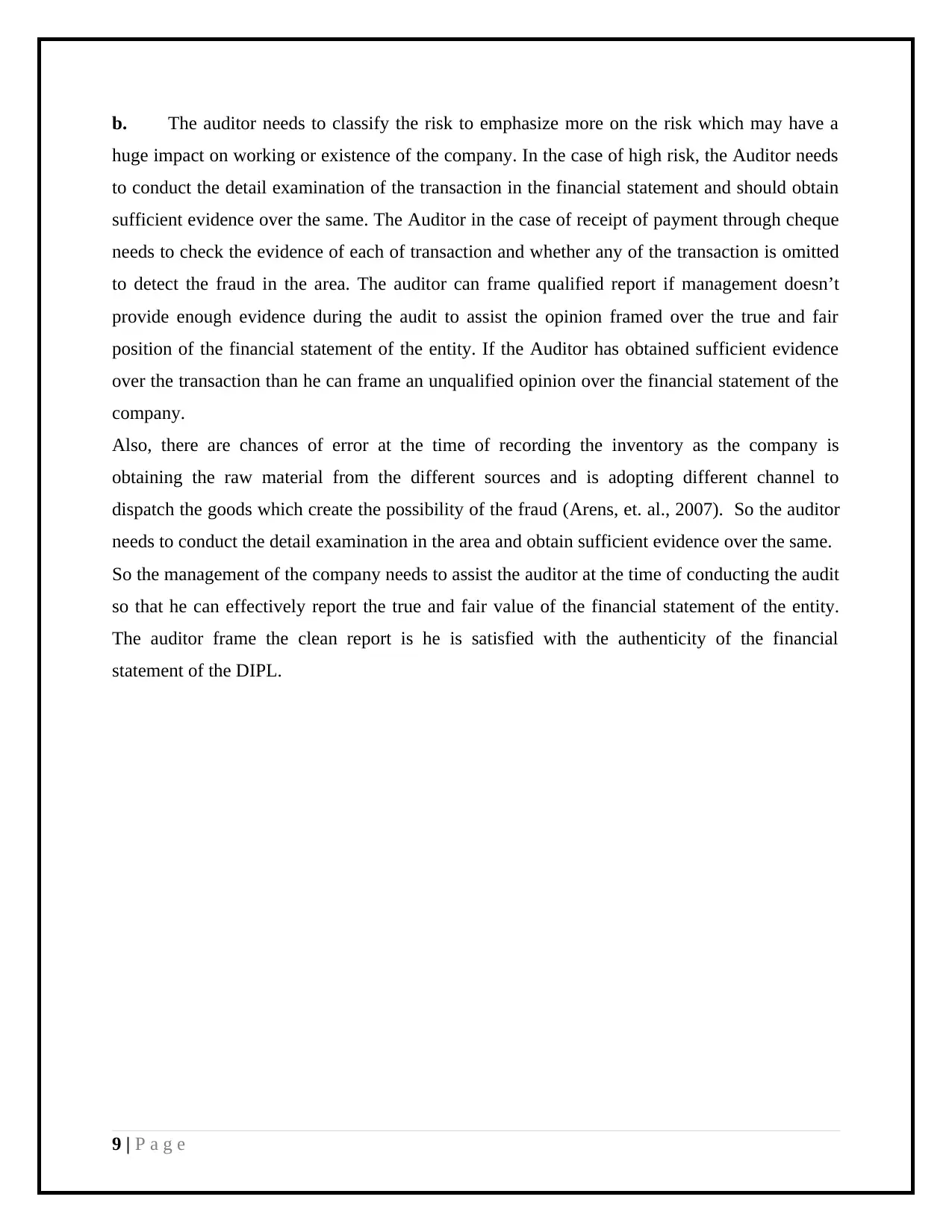
b. The auditor needs to classify the risk to emphasize more on the risk which may have a
huge impact on working or existence of the company. In the case of high risk, the Auditor needs
to conduct the detail examination of the transaction in the financial statement and should obtain
sufficient evidence over the same. The Auditor in the case of receipt of payment through cheque
needs to check the evidence of each of transaction and whether any of the transaction is omitted
to detect the fraud in the area. The auditor can frame qualified report if management doesn’t
provide enough evidence during the audit to assist the opinion framed over the true and fair
position of the financial statement of the entity. If the Auditor has obtained sufficient evidence
over the transaction than he can frame an unqualified opinion over the financial statement of the
company.
Also, there are chances of error at the time of recording the inventory as the company is
obtaining the raw material from the different sources and is adopting different channel to
dispatch the goods which create the possibility of the fraud (Arens, et. al., 2007). So the auditor
needs to conduct the detail examination in the area and obtain sufficient evidence over the same.
So the management of the company needs to assist the auditor at the time of conducting the audit
so that he can effectively report the true and fair value of the financial statement of the entity.
The auditor frame the clean report is he is satisfied with the authenticity of the financial
statement of the DIPL.
9 | P a g e
huge impact on working or existence of the company. In the case of high risk, the Auditor needs
to conduct the detail examination of the transaction in the financial statement and should obtain
sufficient evidence over the same. The Auditor in the case of receipt of payment through cheque
needs to check the evidence of each of transaction and whether any of the transaction is omitted
to detect the fraud in the area. The auditor can frame qualified report if management doesn’t
provide enough evidence during the audit to assist the opinion framed over the true and fair
position of the financial statement of the entity. If the Auditor has obtained sufficient evidence
over the transaction than he can frame an unqualified opinion over the financial statement of the
company.
Also, there are chances of error at the time of recording the inventory as the company is
obtaining the raw material from the different sources and is adopting different channel to
dispatch the goods which create the possibility of the fraud (Arens, et. al., 2007). So the auditor
needs to conduct the detail examination in the area and obtain sufficient evidence over the same.
So the management of the company needs to assist the auditor at the time of conducting the audit
so that he can effectively report the true and fair value of the financial statement of the entity.
The auditor frame the clean report is he is satisfied with the authenticity of the financial
statement of the DIPL.
9 | P a g e
⊘ This is a preview!⊘
Do you want full access?
Subscribe today to unlock all pages.

Trusted by 1+ million students worldwide
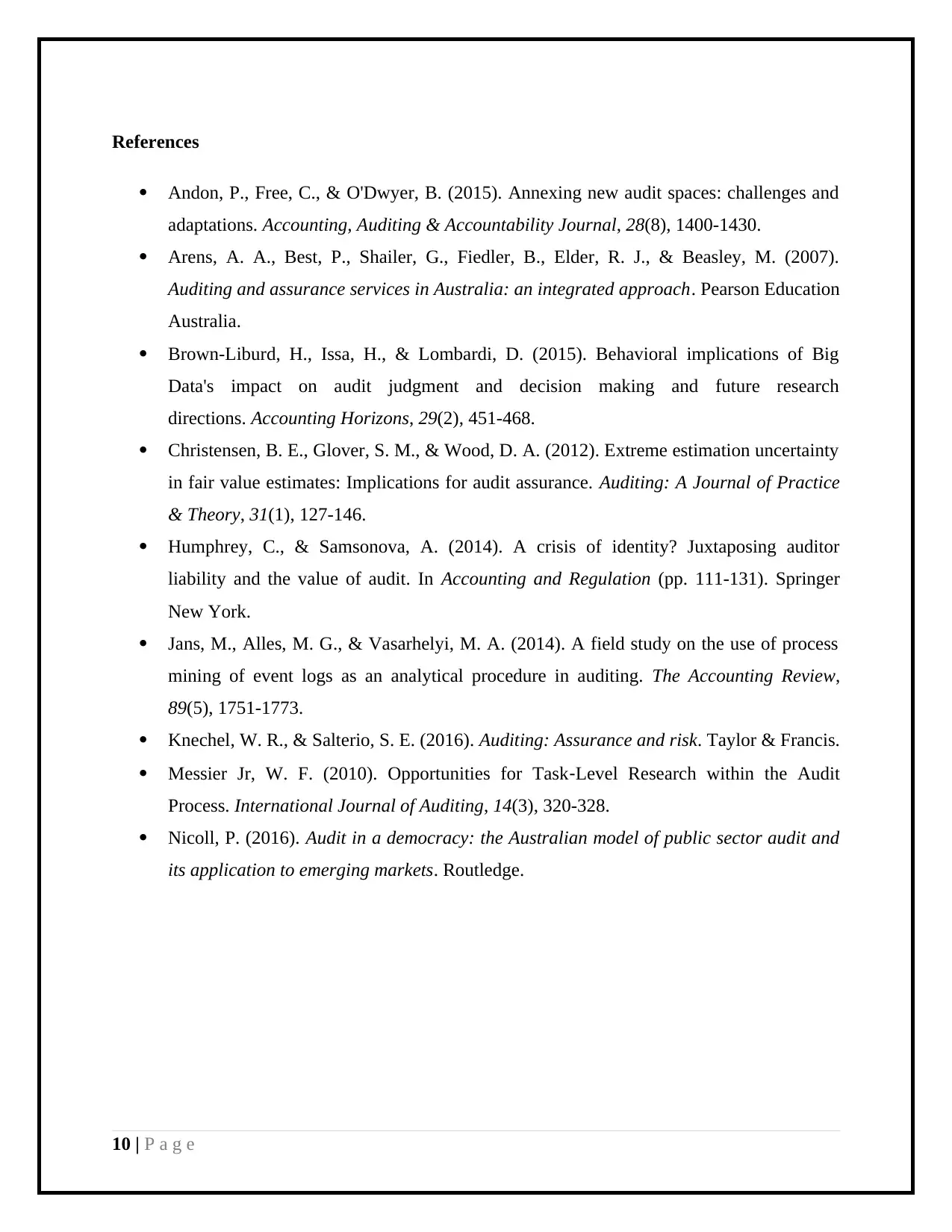
References
Andon, P., Free, C., & O'Dwyer, B. (2015). Annexing new audit spaces: challenges and
adaptations. Accounting, Auditing & Accountability Journal, 28(8), 1400-1430.
Arens, A. A., Best, P., Shailer, G., Fiedler, B., Elder, R. J., & Beasley, M. (2007).
Auditing and assurance services in Australia: an integrated approach. Pearson Education
Australia.
Brown-Liburd, H., Issa, H., & Lombardi, D. (2015). Behavioral implications of Big
Data's impact on audit judgment and decision making and future research
directions. Accounting Horizons, 29(2), 451-468.
Christensen, B. E., Glover, S. M., & Wood, D. A. (2012). Extreme estimation uncertainty
in fair value estimates: Implications for audit assurance. Auditing: A Journal of Practice
& Theory, 31(1), 127-146.
Humphrey, C., & Samsonova, A. (2014). A crisis of identity? Juxtaposing auditor
liability and the value of audit. In Accounting and Regulation (pp. 111-131). Springer
New York.
Jans, M., Alles, M. G., & Vasarhelyi, M. A. (2014). A field study on the use of process
mining of event logs as an analytical procedure in auditing. The Accounting Review,
89(5), 1751-1773.
Knechel, W. R., & Salterio, S. E. (2016). Auditing: Assurance and risk. Taylor & Francis.
Messier Jr, W. F. (2010). Opportunities for Task‐Level Research within the Audit
Process. International Journal of Auditing, 14(3), 320-328.
Nicoll, P. (2016). Audit in a democracy: the Australian model of public sector audit and
its application to emerging markets. Routledge.
10 | P a g e
Andon, P., Free, C., & O'Dwyer, B. (2015). Annexing new audit spaces: challenges and
adaptations. Accounting, Auditing & Accountability Journal, 28(8), 1400-1430.
Arens, A. A., Best, P., Shailer, G., Fiedler, B., Elder, R. J., & Beasley, M. (2007).
Auditing and assurance services in Australia: an integrated approach. Pearson Education
Australia.
Brown-Liburd, H., Issa, H., & Lombardi, D. (2015). Behavioral implications of Big
Data's impact on audit judgment and decision making and future research
directions. Accounting Horizons, 29(2), 451-468.
Christensen, B. E., Glover, S. M., & Wood, D. A. (2012). Extreme estimation uncertainty
in fair value estimates: Implications for audit assurance. Auditing: A Journal of Practice
& Theory, 31(1), 127-146.
Humphrey, C., & Samsonova, A. (2014). A crisis of identity? Juxtaposing auditor
liability and the value of audit. In Accounting and Regulation (pp. 111-131). Springer
New York.
Jans, M., Alles, M. G., & Vasarhelyi, M. A. (2014). A field study on the use of process
mining of event logs as an analytical procedure in auditing. The Accounting Review,
89(5), 1751-1773.
Knechel, W. R., & Salterio, S. E. (2016). Auditing: Assurance and risk. Taylor & Francis.
Messier Jr, W. F. (2010). Opportunities for Task‐Level Research within the Audit
Process. International Journal of Auditing, 14(3), 320-328.
Nicoll, P. (2016). Audit in a democracy: the Australian model of public sector audit and
its application to emerging markets. Routledge.
10 | P a g e
1 out of 10
Related Documents
Your All-in-One AI-Powered Toolkit for Academic Success.
+13062052269
info@desklib.com
Available 24*7 on WhatsApp / Email
![[object Object]](/_next/static/media/star-bottom.7253800d.svg)
Unlock your academic potential
Copyright © 2020–2025 A2Z Services. All Rights Reserved. Developed and managed by ZUCOL.





